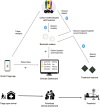Improving pediatric care in Uganda with a digital platform and quality improvement initiative: A retrospective review of Smart Triage + QI
- PMID: 40773450
- PMCID: PMC12331088
- DOI: 10.1371/journal.pone.0329369
Improving pediatric care in Uganda with a digital platform and quality improvement initiative: A retrospective review of Smart Triage + QI
Abstract
Objective: This is a retrospective review of the feasibility study and implementation of the Smart Triage and Quality Improvement (QI) initiative at Holy Innocents Children's Hospital (HICH), a dedicated pediatric hospital in Mbarara, Uganda, over a 5-year period. The aim of this QI initiative was to improve triaging rates and the time-to-antimicrobials in HICH's outpatient department (OPD).
Methods: Smart Triage is a risk prediction algorithm and digital platform that enables healthcare workers to triage patients and track treatments effectively. Following the feasibility study, the QI program was implemented in September 2021 using three Plan-Do-Study-Act cycles: 1) Standardize Training, 2) Adjust Workflows, and 3) QI Team Communication. Data sources were triage and hospital reports. Monthly run charts of OPD attendance, acuity of illness, triaging rates, median-time-to-antimicrobials, and mortality rates of admitted patients were created. The trajectories of the variables were assessed using linear regression with time as the explanatory variable.
Results: 121,521 children attended HICH OPD from November 2018 to October 2023. The OPD triaging rate increased to 91% by October 2023, with a sustained plateau above 90% since July 2022. There was a significant reduction in the median time-to-antimicrobials during the 5-year period, from 77.6 to 53.6 minutes, with a slope of -0.4 minutes per month (CI: -0.73 to -0.04, p-value: 0.029). The inpatient mortality rate decreased from 5.1% in August 2018 to 2.6% in October 2023, with a significant increase in the number of cases with comparable illness severity.
Conclusion: The impact of Smart Triage was sustained beyond the end of the feasibility trial and showed sustained improvements in processes such as treatment times and clinical outcomes including a reduction in mortality. HICH's leadership integrated a culture of QI across disciplines and departments, contributing to this initiative's sustainability and impact.
Copyright: © 2025 Goertzen et al. This is an open access article distributed under the terms of the Creative Commons Attribution License, which permits unrestricted use, distribution, and reproduction in any medium, provided the original author and source are credited.
Conflict of interest statement
The authors have declared that no competing interests exist.
Figures








Similar articles
-
Exploring two-way text messages for post-discharge follow-up and quality improvement in rural Uganda.PLoS One. 2025 Aug 11;20(8):e0322969. doi: 10.1371/journal.pone.0322969. eCollection 2025. PLoS One. 2025. PMID: 40788901 Free PMC article.
-
Systematic review and validation of prediction rules for identifying children with serious infections in emergency departments and urgent-access primary care.Health Technol Assess. 2012;16(15):1-100. doi: 10.3310/hta16150. Health Technol Assess. 2012. PMID: 22452986 Free PMC article.
-
Quality improvement strategies for diabetes care: Effects on outcomes for adults living with diabetes.Cochrane Database Syst Rev. 2023 May 31;5(5):CD014513. doi: 10.1002/14651858.CD014513. Cochrane Database Syst Rev. 2023. PMID: 37254718 Free PMC article.
-
Increasing Trends of Pediatric Thoracic and Lumbar Spine Fractures in the United States from 2004 to 2023: A 20-year National Injury Review Depicting Shifts in Mechanisms of Injury.Clin Orthop Relat Res. 2025 Feb 25;483(8):1542-1553. doi: 10.1097/CORR.0000000000003421. Clin Orthop Relat Res. 2025. PMID: 40036050
-
[Volume and health outcomes: evidence from systematic reviews and from evaluation of Italian hospital data].Epidemiol Prev. 2013 Mar-Jun;37(2-3 Suppl 2):1-100. Epidemiol Prev. 2013. PMID: 23851286 Italian.
References
-
- Weiss SL, Peters MJ, Alhazzani W, Agus MSD, Flori HR, Inwald DP, et al. Surviving sepsis campaign international guidelines for the management of septic shock and Sepsis-Associated organ dysfunction in children. Pediatr Crit Care Med. 2020;21(2). - PubMed
-
- Chiotos K, Weiss SL. A wrinkle in time to antibiotics in sepsis: when should one hour be the goal? J Pediatr. 2021;233:13–5. - PubMed
MeSH terms
LinkOut - more resources
Full Text Sources
Medical

